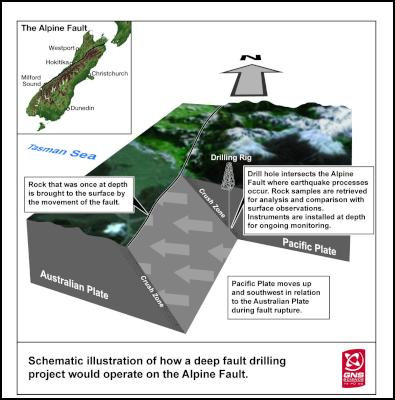Scientists To Probe Alpine Fault
Media Release
20 March 2009
Scientists To Probe Alpine
Fault

Click for big version
Scientists from
around the world will descend on the West Coast of the South
Island next week to discuss an ambitious plan to drill into
the Alpine Fault and learn more about earthquakes.
The project, the first of its kind in New Zealand, aims to drill several kilometres into the Earth’s crust and examine physical and chemical conditions inside the fault. This will provide an important insight into how big faults such as the Alpine Fault evolve and generate earthquakes.
The Alpine Fault extends for more than 650km from south of Fiordland through Milford Sound and along the spine of the South Island into Marlborough. It forms part of the boundary between the Pacific and Australian tectonic plates, which are moving past each other and colliding, forcing up the Southern Alps.
It is one of the world’s major active faults and is visible from space. Geological evidence suggests it ruptures every 200 to 400 years producing earthquakes of about magnitude 8. Scientists believe it last ruptured in 1717.
The Alpine Fault moves at a rate of about 25m every 1000 years - fast by global standards. In between its major ruptures, it is locked and produces few sizeable earthquakes.
From Sunday, 60 scientists from seven countries will gather at Franz Josef for a five-day workshop that will start with a review of the latest geological and geophysical knowledge about the Alpine Fault. They will then develop a drilling plan that meets an agreed set of objectives.
Project Leader, John Townend of Victoria University in Wellington, said the project would involve expertise and funding from many countries and organisations.
A key feature of the Alpine Fault was that it exhumed rocks from within the earthquake generating zone very rapidly in geological terms. This brought rocks associated with earthquake processes within reach of deep drill holes, Dr Townend said.
This provided a globally unique opportunity to study earthquake and other land deformation processes through a combination of surface studies and scientific drilling.
At major plate boundary faults in most other parts of the world, the earthquake generating zone was deep and therefore largely beyond the reach of present drilling technology.
“A key motivation for this project is to provide new understanding of how large faults evolve and generate earthquakes in what is an amazing natural laboratory.
“Potentially, it also offers the chance to develop deep-fault monitoring techniques that could operate for many years,” Dr Townend said.
As well as penetrating the earthquake zone and extracting rocks for analysis, scientists hope to install a variety of underground instruments that may shed light on the timing and severity of earthquakes and other forms of tectonic deformation on the Alpine Fault.
Lowering instruments into the heart of the fault would enable scientists to investigate a range of processes not normally accessible to them. Measurements would include pressure, temperature, rock fracturing, and the chemistry of fluids, rocks and gases.
Dr Townend said a large earthquake on the Alpine Fault could strike this century, and there was a compelling case to install instruments at depth to better understand and monitor the South Island’s most dangerous fault.
Monitoring equipment had been successfully installed deep inside major faults in several countries including Japan, Taiwan, and the United States. Scientists who led the San Andreas Fault Observatory at Depth (SAFOD) deep drilling project will attend the workshop to share their knowledge.
The workshop has been made possible through funding awarded by the International Continental Scientific Drilling Programme.
END


 John Mazenier: Gaffer Tape And Glue Delivering New Zealand’s Mission Critical Services
John Mazenier: Gaffer Tape And Glue Delivering New Zealand’s Mission Critical Services Earthquake Commission: Ivan Skinner Award Winner Inspired By Real-life Earthquake Experience
Earthquake Commission: Ivan Skinner Award Winner Inspired By Real-life Earthquake Experience Reserve Bank: Consultation Opens On A Digital Currency For New Zealand
Reserve Bank: Consultation Opens On A Digital Currency For New Zealand NIWA: Ship Anchors May Cause Extensive And Long-lasting Damage To The Seafloor, According To New Research
NIWA: Ship Anchors May Cause Extensive And Long-lasting Damage To The Seafloor, According To New Research New Zealand Customs Service: A Step Forward For Simpler Trade Between New Zealand And Singapore
New Zealand Customs Service: A Step Forward For Simpler Trade Between New Zealand And Singapore Horizon Research: 68% Say Make Banks Offer Fraud Protection
Horizon Research: 68% Say Make Banks Offer Fraud Protection



